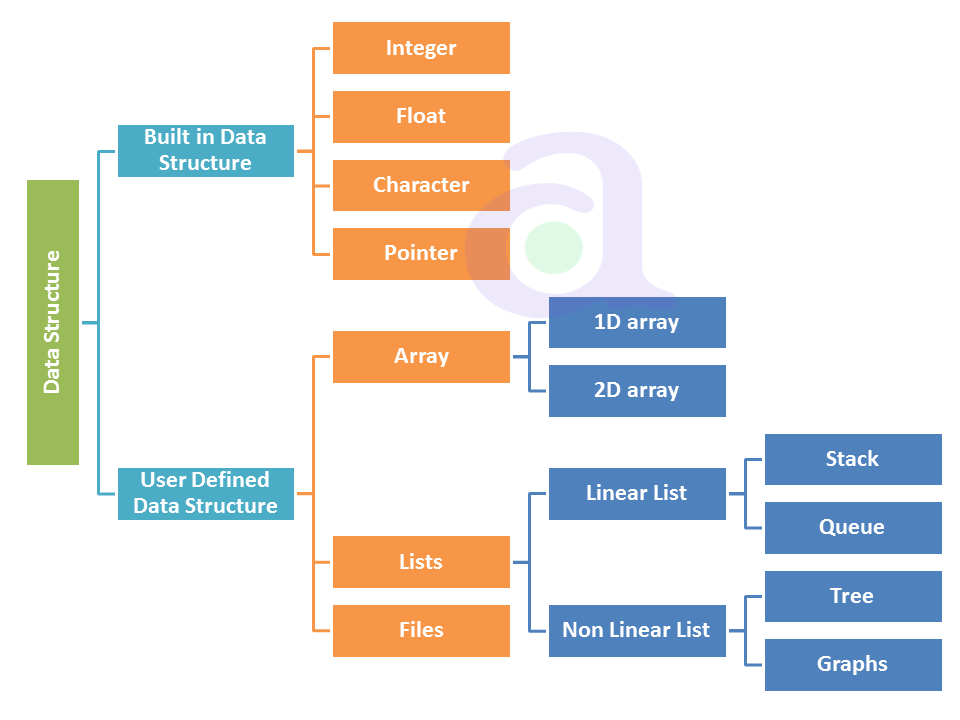
Various types of Data structures
Table of Content:
Anything that can store data can be called as a data structure, hence Integer, Float, Boolean, Char etc, all are data structures. They are known as Primitive Data Structures.
Then we also have some complex Data Structures, which are used to store large and connected data. Some example of Abstract Data Structure(ADT) are :
- Stack
- Queue
- Linked List
- Tree
- Graph
- etc.
All these data structures allow us to perform different operations on data. We select these data structures based on which type of operation is required. We will look into these data structures in more details in our later lessons.

Descriptions:
Linear:
In Linear data structures,the data items are arranged in a linear sequence.
Example: Array
Non-Linear:
In Non-Linear data structures,the data items are not in sequence.
Example: Tree, Graph
Homogeneous:
In homogeneous data structures,all the elements are of same type.
Example: Array
Non-Homogeneous:
In Non-Homogeneous data structure, the elements may or may not be of the same type.
Example: Structures
Static:
Static data structures are those whose sizes and structures associated memory
locations are fixed, at compile time.
Example: Array
Dynamic:
Dynamic structures are those which expands or shrinks depending upon the program need and its execution. Also, their associated memory
locations changes.
Example: Linked List created using pointers
Array
Arrays are a very simple data structure and may be thought of as a list of a fixed length. Arrays are nice because of their simplicity, and are well suited for situations where the number of data items is known (or can be programmatically determined). Suppose you need a piece of code to calculate the average of several numbers. An array is a perfect data structure to hold the individual values, since they have no specific order, and the required computations do not require any special handling other than to iterate through all of the values. The other big strength of arrays is that they can be accessed randomly, by index. For instance,
if you have an array containing a list of names of students seated in a classroom, where each seat is numbered 1
through n, then studentName[i] is a trivial way to read or store the name of the student in seat i.
An
the array might also be thought of as a pre-bound pad of paper. It has a fixed number of pages,
each page holds information, and is in a predefined location that never changes.
Linked Lists
A linked list is a data structure that can hold an arbitrary number of data items and can easily change size to add or remove items. A linked list, at its simplest, is a pointer to a data node. Each data node is then composed of data (possibly a record with several data values), and a pointer to the next node. At the end of the list, the pointer is set to null.
Queues
A queue is a data structure that is best described as "first in, first out". A real-world example of a queue is people waiting in line at the bank. As each person enters the bank, he or she is "enqueued" at the back of the line. When a teller becomes available, they are "dequeued" at the front of the line.
Priority Queues
In a typical breadth-first search (BFS) algorithm, a simple queue works great for keeping track of what states have been visited. Since each new state is one more operational step than the current state, adding new locations to the end of the queue is sufficient to ensure that the quickest path is found first. However, the assumption here is that each operation from one state to the next is a single step.
Stacks
Stacks are, in a sense, the opposite of queues, in that they are described as "last in, first out". The classic example is the pile of plates at the local buffet. The workers can continue to add clean plates to the stack indefinitely, but every time, a visitor will remove from the stack the top plate, which is the last one that was added.
Trees
Trees are a data structure consisting of one or more data nodes. The first node is called the "root", and each node has zero or more "child nodes". The maximum number of children of a single node, and the maximum depth of children are limited in some cases by the exact type of data represented by the tree.
Binary Trees
A special type of tree is a binary tree. A binary tree also happens to be one of the most efficient ways to store and read a set of records that can be indexed by a key value in some way. The idea behind a binary tree is that each node has, at most, two children.
Hash Tables
Hash tables are a unique data structure and are typically used to implement a "dictionary" interface, whereby a set of keys each has an associated value. The key is used as an index to locate the associated values. This is not unlike a classical dictionary, where someone can find a definition (value) of a given word (key).